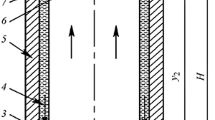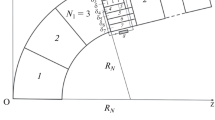Simulation of the influence of the parameters of film flow of the heat-transfer agent under gravity on the operation of a closed thermosyphon has been performed. It has been shown that in the stationary regime, the film thickness is under 100 μm. The main factors governing the efficiency of the thermosyphon are the power of the heat source, the area of the condenser, and also the viscosity and thermal conductivity of a liquid heat-transfer agent. The stability of film flow to a short-duration increase in the heat-source power has been considered.
Similar content being viewed by others
References
M. Moustaid, V. Platel, M. Guillet, H. Reynes, and C. Buttay, Modeling and test of a thermosyphon loop for the cooling of a megawatt-range power electronics converter, Int. J. Thermofluids, 13, Article ID 100129 (2022).
X. Chen Ding, H. Cao, Z. He, J. Wang, and Z. Li, Principles of loop thermosyphon and its application in data center cooling systems: A review, Renew. Sustain. Energy Rev., 150, Article ID 111389 (2021).
D. Khrustalev, Loop thermosyphons for cooling of electronics, Proc. Eighteenth Annual IEEE Semiconductor Thermal Measurement and Management Symposium, IEEE (2002), pp. 145–150.
S. Fertahi, T. Bouhal, Y. Agrouaz, T. Kousksou, T. El Rhafiki, and Y. Zeraouli, Performance optimization of a two-phase closed thermosyphon through CFD numerical simulations, Appl. Therm. Eng., 128, 551–563 (2018).
V. G. Levich, Physicochemical Hydrodynamics [in Russian], Gos. Izd. Fiz.-Mat. Lit., Moscow (1959).
Yu. A. Khodyko, V. I. Saverchenko, and S. P. Fisenko, Features of evaporation of an ensemble of femto-picoliter droplets on a substrate. Experiments and simulation, Interfac. Phenom. Heat Transf., 6, Issue 3, 231–238 (2018).
S. P. Fisenko and Yu. A. Khodyko, Numerical investigation of the low-pressure evaporative cooling of a substrate, J. Eng. Phys. Thermophys., 91, No. 1, 96–103 (2018).
Author information
Authors and Affiliations
Corresponding author
Additional information
Translated from Inzhenerno-Fizicheskii Zhurnal, Vol. 95, No. 6, pp. 1448–1452, November–December, 2022.
Rights and permissions
Springer Nature or its licensor (e.g. a society or other partner) holds exclusive rights to this article under a publishing agreement with the author(s) or other rightsholder(s); author self-archiving of the accepted manuscript version of this article is solely governed by the terms of such publishing agreement and applicable law.
About this article
Cite this article
Fisenko, S.P. Film Flow of the Heat-Transfer Agent in a Closed Thermosyphon. J Eng Phys Thermophy 95, 1421–1425 (2022). https://doi.org/10.1007/s10891-022-02610-y
Received:
Published:
Issue Date:
DOI: https://doi.org/10.1007/s10891-022-02610-y




